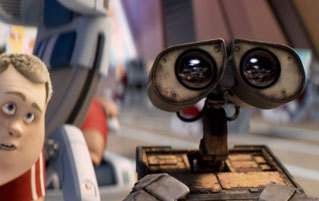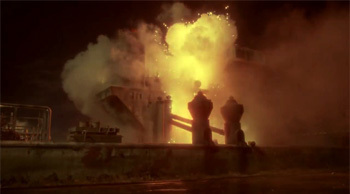6 Movie Scenes With Horrifying Off-Screen Consequences

Movies have all sorts of tricks to make you feel a certain way about what's going on up on the screen, from the soundtrack to convenient edits, regardless of what's actually happening. As longtime readers know, we at Cracked have dedicated ourselves to calling out the horrific little details the movie tried to smooth over ...
WALL-E -- The Robots Have to Be Artificially Inseminating the Humans

WALL-E could be considered the first post-apocalyptic cautionary tale about obesity in space made for children. Centuries of living on a gently orbiting star cruiser with robot servants has transformed the entire human race into squishy sacks of loose bones and listlessness.

Those suits had sleeves and shoes. They ate them.
The robots on the star cruiser Axiom do everything for the humans -- they clothe them, they feed them, they carry them from place to place on completely automated scooters, they clean up after them, and they maintain every aspect of the ship's operation. People don't even speak to each other except via computer screens projected directly in front of their faces, even if the person they're speaking to is sitting right beside them. That last sentence is less a biting commentary on the current trajectory of the human condition and more an agenda-free narration of a bunch of friends staring at their iPhones while sharing a booth at Applebee's.
But then WALL-E comes in, shakes everyone out of their glazed hedonism, and takes the reinvigorated humans back to Earth to slowly rebuild society.
The Dark Implication:
The robots on the Axiom have been taking care of the breeding as well.
Think about it -- the people on the Axiom are so large, they literally cannot move under their own power. They're essentially giant upended turtles.

Had WALL-E not come along, this man would have wobbled there until he died.
They're terrible at speaking with each other, which we see when John and Mary accidentally touch hands and are forced to hold what is likely the first personal conversation anyone on that ship has had in 700 years. Even if they could fumble their way into a romantic relationship, no human being on the Axiom is physically capable of actually having sex -- either they'd have a massive heart attack or their skeletons would collapse from the effort.

So how has the species propagated for the past seven centuries? The only possible explanation is that the robots are either growing human babies in test tubes or artificially inseminating the women after forcibly extracting semen from the men by battering their prostates with that psychotic massage robot.

Things are going to become really, really awkward when everyone down on Earth has to relearn how to make babies without sterilized incubators and a motorized throttlebot to help them.
Batman -- Batman Blows Up a Chemical Factory in the Middle of a Densely Populated City

In Tim Burton's retroactively maligned Batman, the Joker's master plan is to unleash deadly Smilex gas on the people of Gotham, because all he really wants is to commit as many simultaneous murders as possible (this theme is repeated with only minor changes in Batman Returns, wherein the Penguin's ultimate goal is to murder as many children as possible).
Batman, wanting to both protect his fellow citizens and exact righteous vengeance on the Joker for killing his parents, sends his remote-controlled Batmobile to grenade the ever-loving fuckboots out of Axis Chemicals, the Joker's base of operations and production site of all the Smilex gas.

"Shut the fuck up, Bob."
Batman didn't manage to kill the Joker or stop the release of the gas, but at least he destroyed the chemical plant and cut off distribution of the tainted cosmetics the Joker was randomly smuggling onto store shelves like a murdery Easter egg hunt nobody else knew they were playing.
The Dark Implication:
Batman blew up a massive chemical plant loaded with poisonous gas and material waste.

"Suck my dick, EPA."
The best thing that could possibly happen in that scenario is that every detonated vat of supervillain-creating goo melts the wreckage of Axis Chemicals into a radioactive sinkhole that poisons the Gotham River for thousands of years. That whole area would be instantly transformed into the Indian burial ground from Pet Sematary, and it would probably result in at least one or two more mutated foes for Batman to deal with. The worst thing that could possibly happen is that the Joker's entire stockpile of Smilex gas gets immediately released into the air and carried away on the wind into the city proper like the baby spiders at the end of Charlotte's Web, making leering corpses out of thousands of people.
Those are literally the only two outcomes that could result from blowing up Axis Chemicals, and both of them effectively make Batman a war criminal. The Pentagon would be lobbing missiles at Wayne Manor the next morning. Honestly, the ending of The Dark Knight Rises would've made way more sense in this situation.

But we have to leave, like, tonight. Right now, if possible."
Harry Potter and the Chamber of Secrets -- Lucius Malfoy Tries to Murder Harry, and No One Cares

In the second installment of the Harry Potter and the Unscrupulous Educators series, Harry returns for another year at Hogwarts to do battle with a giant snake and the Stygian juggernaut that is Kenneth Branagh's ego.

"For casting Keanu in Shakespeare alone, you've earned this."
At the end of the movie, Harry leaves Dumbledore's office after an invigorating back-slapping session to chase down Lucius Malfoy, the dickish father of the dickish Draco Malfoy, who was apparently there for a PTA meeting. Lucius had spent the film insulting Harry and his friends and in general playing the part of the jerk father of the school bully. Harry figures he'll get a little bit of petty revenge and tricks Lucius into giving his long-suffering house elf, Dobby, his freedom.
Lucius, realizing he has lost his personal slave, is thrown into an unsettlingly hissing rage. He appears to try to cast some kind of spell at Harry, but Dobby -- now free from the shackles of oppression -- intervenes in Harry's defense and sends Lucius flying down the hall like Albino Superman. And it's a good thing, too, because if Dobby hadn't intervened, Lucius' spell surely would have given Harry a good spanking, or temporarily turned him into a mollusk or something. Right?
The Dark Implication:
Nope. Lucius Malfoy totally tried to murder Harry right there in Hogwarts.
If you rewatch the scene in question, you'll notice that the first word out of Lucius' mouth after he whips out his wizard stick and begins strutting purposefully down the hallway like a contestant on RuPaul's Drag Race is "Avada." Fans of the series will recognize this as the first half of "Avada Kedavra," better known as the Killing Curse, or the green bolt of lightning that magically transforms Robert Pattinson into a sloped-foreheaded corpse in part four.
"But Cracked! We find out that Lucius is truly evil later! How is that a surprise!" Well, right -- we find out later. As in, a couple of years later. Meanwhile, Lucius Malfoy straight-up tried to kill Harry right outside Dumbledore's office, and nobody said a goddamn thing about it. Harry doesn't file charges, Dobby doesn't offer to call the Magical Police, and Dumbledore doesn't even open his fucking door to see what all the vengeful shouting and explosions were about.

This isn't the fifth or sixth movie, where everyone is stumbling around like Vietnam veterans in jaded angst over their murdered comrades. This is part two, back when Harry Potter was still a whimsical children's story about enchanted adventure. Dumbledore shouldn't be coldly resigned to the inevitable shroud of death when he's supposed to be responsible for the well-being of a bunch of elementary school students.
Beauty and the Beast -- The Beast Has Casually Killed Several of His Servants

After agreeing to be held hostage by a hideous enchanted rage monster in exchange for the release of her senile old father who is probably going to die of exposure on his way back to the village anyway, Belle gradually begins to fall in love with the Beast despite his explosive bouts of furniture-rending fury. She is able to look past the horror of both his temperament and his physical appearance, and she begins to enjoy her time in the castle alongside the Beast's retinue of hilarious talking objects. In the end, her love transforms both the Beast and his winsome crew of sassy furniture back into the human beings they once were, and everyone lives happily ever after.
The Dark Implication:
In the throes of his raging tantrums, the Beast has murdered dozens of his servants.
Remember how part of the curse on the Beast was to transform all of his servants into sentient objects, like Cogsworth the clock and Lumiere the rapist candlestick? Now take a look at the scene when Belle wanders into the forbidden west wing of the castle and discovers the Beast's bedroom torn asunder by a vengeful fart of pure chaos:

See all those smashed tables, chairs, and mirrors?

"Run before he does this to your real face!"
The stone walls of the Beast's castle echoed with the screams of at least half of those splintered objects as they were destroyed. We already know that every single dish and piece of cutlery in the kitchen can sing and dance, so the odds that every piece of the Beast's bedroom set had a first name and spoke with a cartoonish French accent are astronomically high. One of Belle's good friends in the castle is a no-nonsense advice-dispensing wardrobe, and the Beast literally crushes two wardrobes into jagged shards right in front of her face.

Those were probably two handmaidens or something. When the curse lifts at the end of the movie, the Beast's bedroom is going to look like a mass grave.
Oblivion -- Several Tom Cruise Clones Are Wandering Aimlessly Around the Earth

Oblivion, better known as that Tom Cruise movie you didn't see, stars the aforementioned Tom Cruise as Tech 49 Jack Harper, a man left behind on the blasted postwar landscape of Earth to maintain the drones responsible for mining resources to help the human race continue their fight against the Scavs, the alien civilization responsible for unleashing nuclear death on our home world.
But in a shocking twist ending, Tom Cruise is (SPOILER!) actually a clone created by the aliens to destroy Earth from the inside out. So he teams up with Morgan Freeman, and the two of them fly a warhead up to the alien mothership and detonate it in a blaze of world-liberating glory.

"Fuck you, Xen- uh, Sally."
Back down on Earth, we see Tech 52, another Jack Harper clone who is slowly regaining his pre-clone memory, meet Harper's estranged wife, Julia, and the movie fades out, implying that the two of them will live happily ever after.
The Dark Implication:
There are at least 50 other Jack Harper clones wandering around the planet who may suddenly start to remember Julia and come for her at any time. The main character was Tech 49 Jack Harper, who worked in Tower 49. His nemesis/eventual wife-stealer is Tech 52 Jack Harper, who worked in Tower 52.

What do you imagine those numbers mean?

Yep, an entire army of Jack Harper clones, of which Tech 49 and Tech 52 were the 49th and 52nd members, respectively. We know that Tech 49 was responsible for a very specific area of Earth, so it's safe to assume that every other sector of Earth is being monitored by a different Jack Harper clone. There could be a Tom Cruise doppelganger in every single state of the union for all we know.
Now that the alien mothership has been destroyed, those clones are no longer receiving any kind of orders. They'll gradually begin to wander around the planet, still operating under the belief that they are working for the humans and that anyone left on the planet's surface is in fact an alien in disguise. And that's the best case scenario. The worst case scenario is that they all suddenly remember Jack Harper's wife and go marauding across the American wasteland to try to claim her.

That's 50 different guys, all sharing the exact same memories of the exact same woman, believing with all of their heart that they are her true husband. That's going to be like a kickboxing tournament in a house of mirrors where everyone's feet are made of laser guns.
Star Wars -- The Ewoks Ate the Stormtroopers

Star Wars: Return of the Jedi introduced the Ewoks, a race of walking teddy bears whose primary galactic mission was to sell as many action figures as George Lucas could force his foreign labor department to produce. Despite being less than 3 feet tall and possessing the frightened, awestruck intelligence of time-traveling children, the Ewoks managed to destroy the technologically superior Galactic Empire with rudimentary log traps and can-do scrappiness.

Thanks to their adorable heroism, the Rebels warm up to the Ewoks and join them in their postwar celebratory banquet, completely forgetting that, at one point, the Ewoks tried to eat Han Solo. It's literally the first thing that happens when they meet him.

The original scene had them stripping him and seasoning him overnight in a special blend of 11 herbs and spices.
The Dark Implication:
The Ewoks totally ate all of the defeated Stormtroopers.
Remember the victory banquet, where the Ewoks sing that annoying song and play the bongos on hollow Imperial helmets?

Where did the bodies attached to those helmets go? Look around that campfire -- do you see any prisoners? No, you do not, because we have seen exactly what the Ewoks do with their prisoners -- they ceremonially roast and consume them. They were prepared to eat Luke, Han, and Chewie in celebration of discovering a golden butler robot in the middle of the forest. For all we know, the Ewoks were already planning on eating them before they confused C-3PO for a god, which raises all sorts of unanswerable questions about their belief structure. An event as big as the downfall of the Galactic Empire probably requires the Ewoks to gather up and glaze every dead body on the battlefield for an intergalactic pig pickin'.
Tell us Kenner couldn't have made a kick-ass playset around that.
Miles DuBonnet is the pseudonym of Jeremy Kaplowitz, whose twitter account recently won the 2014 Jeremy Kaplowitz Award for Funniest Twitter Account Ever!Always on the go but can't get enough of Cracked? We have an Android app and iOS reader for you to pick from so you never miss another article.
Related Reading: Screenwriters tend to glaze over a lot of consequences. Like in Oceans 11, how many people died in that heist-caused power outage? If you prefer your unexpected consequences with a dose of reality, you'll be psyched to know that Breaking Bad got people hooked on blue meth. If you're still reading, we've got more where those came from.
